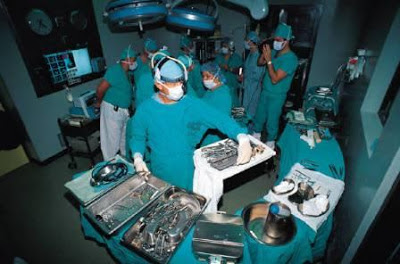Due to increased use of next generation devices, systems, and instruments to manage surgery through small ports in the body instead of large open wounds, global surgical robot device market which was at $3.2 billion in 2012 is anticipated to reach $19.96 billion by 2019. For more information visit: Surgical Robots: Market Shares, Strategies, and Forecasts, Worldwide, 2013-2019
Compared with other minimally invasive surgery approaches, robot-assisted surgery gives the surgeon better control over the surgical instruments and a better view of the surgical site. Surgeons no longer have to stand throughout the surgery and do not tire as quickly. Hand tremors are filtered out by the robot’s computer software. The surgical robot can continuously be used by rotating surgery teams.
During a robot assisted surgical procedure, the patient-side cart is positioned next to the operating table with the electromechanical arms arranged to provide access to the initial ports selected by the surgeon. Metal tubes attached to the arms are inserted through the ports, and the cutting and visualization instruments are introduced through the tubes into the patient’s body.
Spanning over 379 pages 144 tables and figures, “Surgical Robots: Market Shares, Strategies, and Forecasts, Worldwide, 2013-2019” report presents an in-depth assessment of the surgical robots market from 2013 till 2019.
In addition to covering the Surgical Robots Market Description and Market Dynamics, Surgical Robot Market Shares and Forecasts, Surgical Robots Product Description, Medical Robot Technology, Surgical Robots Company Description the report also presents Robotic Surgery Equipment Market Forecasts for the Surgical Robots market 2013 - 2019. The report covers major industry players including Intuitive Surgical, Hansen Medical, Curexc Technology Corporation, iRobot, MAKO Surgical, Accuray, Restoration Robotics and Titan Medical. Browse more: Medical Devices Market Research Reports
Compared with other minimally invasive surgery approaches, robot-assisted surgery gives the surgeon better control over the surgical instruments and a better view of the surgical site. Surgeons no longer have to stand throughout the surgery and do not tire as quickly. Hand tremors are filtered out by the robot’s computer software. The surgical robot can continuously be used by rotating surgery teams.
During a robot assisted surgical procedure, the patient-side cart is positioned next to the operating table with the electromechanical arms arranged to provide access to the initial ports selected by the surgeon. Metal tubes attached to the arms are inserted through the ports, and the cutting and visualization instruments are introduced through the tubes into the patient’s body.
Spanning over 379 pages 144 tables and figures, “Surgical Robots: Market Shares, Strategies, and Forecasts, Worldwide, 2013-2019” report presents an in-depth assessment of the surgical robots market from 2013 till 2019.
In addition to covering the Surgical Robots Market Description and Market Dynamics, Surgical Robot Market Shares and Forecasts, Surgical Robots Product Description, Medical Robot Technology, Surgical Robots Company Description the report also presents Robotic Surgery Equipment Market Forecasts for the Surgical Robots market 2013 - 2019. The report covers major industry players including Intuitive Surgical, Hansen Medical, Curexc Technology Corporation, iRobot, MAKO Surgical, Accuray, Restoration Robotics and Titan Medical. Browse more: Medical Devices Market Research Reports

No comments:
Post a Comment
Note: only a member of this blog may post a comment.